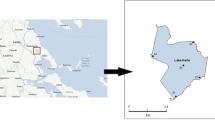Abstract
The results of numerical modelling of large-scale circulation in Lakes Onega and Ladoga are presented, with primary emphasis on the temporal variability of currents with time scales of days. Some typical circulation patterns have been inferred from model calculations. They reflect the existence of different dynamic regimes in the lakes, namely, forced and free circulation regimes. The forced circulation regime is the well-known wind-induced double-gyre circulation accompanied by coastal upwelling and downwelling. A case of double-gyre circulation in Lake Onega was investigated in particular detail. The second dynamic regime is a free response (or a relaxation) of the stratified lake to wind cessation, and is connected closely with the evolution of wind-induced upwelling and thermal front propagation. Diagnostic calculations demonstrate that the regime of relaxation supports the restoration of cyclonic circulation in Lake Onega. Barotropic circulation patterns in Lake Ladoga were calculated with the emphasis on prevailing winds from west to south-east. Our calculations show that the bottom relief of Lake Ladoga causes asymmetry in the double-gyre circulation patterns. In particular, approximately equal cyclonic and anticyclonic circulation cells appearing in the case of southerly wind transform to a single dominant cyclonic cell and several small anticyclonic cells in the case of westerly wind. We also found especially strong sensitivity of the sense of rotation of the largest gyre to the east-west components of the wind vector.
Similar content being viewed by others
References
Astrakhantsev, G. P., N. B. Egorova & L. A. Rukhovets, 1988. Modelirovanie techeniy i termicheskogo rezhima Ladozhskogo ozera. Institut ozerovedeniya, Akademii Nauk SSSR, Leningrad, 44 pp. [Modelling of currents and thermal regime of Lake Ladoga. In Russian].
Beletsky, D. V., Yu. L. Demin & N. N. Filatov, 1991. Comprehensive investigations of hydrophysical fields in Lake Onega as an ocean simulation model. Bull (Izv.) Acad. Sci. USSR, Atmosph. Oceanic Phys. 27: 854–861.
Bennett, J. R., 1974. On the dynamics of wind-driven lake currents. J. Phys. Oceanogr. 4: 400–414.
Csanady, G. T., 1977. Intermittent ‘full’ upwelling in Lake Ontario. J. Geophys. Res. 82: 397–419.
Csanady, G. T. & G. T. Scott, 1974. Baroclinic coastal jets in lake Ontario during IFYGL. J. Phys. Oceanogr. 4: 524–541.
Demin, Y. L. & R. A. Ibraev, 1989. A numerical method of calculation of currents and sea surface topography in multiply connected domains of the oceans. Sov. J. Numer. Anal. Math. Modelling. 4: 211–225.
Demin, Yu. L., D. V. Beletsky & N. N. Filatov, 1989. Diagnostic calculation of the summer water circulation of Lake Onega. Bull. (Izv.) Acad. Sci. USSR, Atmosph. Oceanic Phys. 25: 410–411.
Emery, K. O. & G. T. Csanady, 1973. Surface circulation of lakes and nearly land-locked seas. Proc. Nat. Acad. Sci. U.S. 70: 93–97.
Filatov, N. N. 1983. Dinamika ozer. Gidrometeoizdat, Leningrad, 163 pp. [Dynamics of lakes. In Russian].
Kvon, V. I., T. V. Rotatova & T. N. Filatova, 1991. Chislennoe modelirovanie nestratifitsirovannykh techeniy Ladozhskogo ozera. In M. N. Shimaraev (ed.), Gidrofizika i gidrologiya vodoemov. Nauka, Novosibirsk: 80–89. [Numerical modelling of barotropic currents in Lake Ladoga. In Russian].
Mortimer, C. H., 1963. Frontiers in physical limnology with particular reference to long waves in rotating basins. Great Lakes Res. Div. Publ. (University of Michigan) 10: 9–42.
North-West Regional Administration on Hydrometeorology and Environmental Monitoring, 1986. Mnogoletnie dannye o rezhime i resursakh poverkhnostnykh vod sushi. 1 (5). Leningrad, 688 pp. [Long-term data on surface waters regime and resources. In Russian].
Okhlopkova, A. N., 1961. Opyt primeneniya dinamicheskogo metoda k izucheniyu tsirkulyatsii vod Ladozhskogo ozera. Okeanologiya 1: 1025–1033. [Investigations of circulation in Lake Ladoga with use of the dynamic height method. In Russian].
Okhlopkova, A. N., 1972. Techeniya Onezhskogo ozera. In T. I. Malinina (ed.) Dinamika vodnykh mass Onezhskogo ozera. Nauka, Leningrad, 74–114. [Currents in Lake Onega. In Russian].
Simons, T. J., 1973. Development of three-dimensional numerical models of Great Lakes. Can. Inland Water Branch. Sci. Ser. 12, 26 pp.
Simons, T. J. & W. M. Schertzer, 1987. Stratification, currents and upwelling in Lake Ontario, summer 1982. Can. J. Fish. Aquat. Sci. 44: 2047–2058.
Author information
Authors and Affiliations
Rights and permissions
About this article
Cite this article
Beletsky, D.V. Numerical modelling of large-scale circulation in Lakes Onega and Ladoga. Hydrobiologia 322, 75–80 (1996). https://doi.org/10.1007/BF00031808
Issue Date:
DOI: https://doi.org/10.1007/BF00031808




